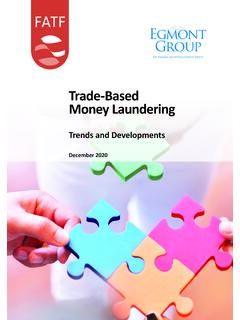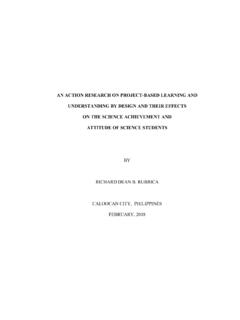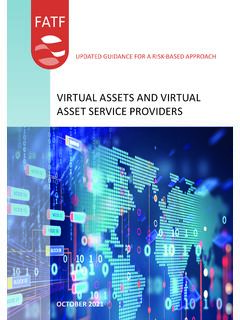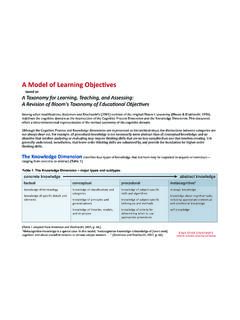Transcription of Protection - Guidelines for Integrating Gender-Based ...
1 Thematic Area Guide for: Guidelines for Integrating Gender-Based Violence Interventions in Humanitarian action Reducing risk, promoting resilience and aiding recovery Camp Coordination and Camp Management Child Protection Education Food Security and Agriculture Health Housing, Land and Property Humanitarian Mine action Livelihoods Nutrition Protection Shelter, Settlement and Recovery Water, Sanitation and Hygiene Humanitarian Operations Support Sectors IASC. Inter-Agency Standing Committee Acknowledgements This Thematic Area Guide (TAG) is excerpted from the comprehensive Inter-Agency Standing Committee Guidelines for Integrating Gender-Based Violence Interventions in Humanitarian action : Reducing risk, promoting resilience and aiding recovery (IASC, 2015), available at < >.
2 The lead authors were Jeanne Ward and Julie Lafreni re, with support from Sarah Coughtry, Samira Sami and Janey Lawry-White. The comprehensive Guidelines were revised from the original 2005 IASC Guidelines for Gender-Based Violence Interventions in Humanitarian Settings. The revision process was overseen by an Operations Team led by UNICEF. Operations team members were: Mendy Marsh and Erin Patrick (UNICEF), Erin Kenny (UNFPA), Joan Timoney (Women's Refugee Commission) and Beth Vann (independent consul- tant), in addition to the authors. The process was further guided by an inter-agency advisory board ( Task Team') of 16 organizations including representatives of the global GBV Area of Responsibility (GBV AoR).
3 Co-lead agencies UNICEF and UNFPA as well as UNHCR, UN Women, the World Food Programme, expert NGOs (the American Refugee Committee, Care International, Catholic Relief Services, ChildFund International, InterAction, International Medical Corps, International Rescue Committee, Oxfam Interna- tional, Plan International, Refugees International, Save the Children and Women's Refugee Commission), the Centers for Disease Control and Prevention and independent consultants with expertise in the field. The considerable dedication and contributions of all these partners has been critical throughout the entire revision process.
4 The content and design of the revised Guidelines was informed by a highly consultative process that involved the global distribution of multi-lingual surveys in advance of the revision process to help define the focus and identify specific needs and challenges in the field. In addition, detailed inputs and feedback were received from over 200 national and international actors both at headquarters and in-country, rep- resenting most regions of the world, over the course of two years and four global reviews. Draft content of the Guidelines was also reviewed and tested at the field level, involving an estimated additional 1,000.
5 Individuals across United Nations, INGO and government agencies in nine locations in eight countries. The Operations and Task Teams would like to extend a sincere thank you to all those individuals and groups who contributed to the Guidelines revision process from all over the world, particularly the Clus- ter Lead Agencies and cluster coordinators at global and field levels. We thank you for your input as well as for your ongoing efforts to address GBV in humanitarian settings. We would like to thank the United States Government for its generous financial support for the revision process. A Global Reference Group has been established to help promote the Guidelines and monitor their use.
6 The Reference Group is led by UNICEF and UNFPA and includes as its members: American Refugee Committee, Care International, the Centers for Disease Control and Prevention, ChildFund International, International Medical Corps, International Organization for Migration, International Rescue Committee, Norwegian Refugee Council, Oxfam, Refugees International, Save the Children, UNHCR and Women's Refugee Commission. For more information about the implementation of the revised Guidelines , please visit the GBV Guide- lines website < >. This website hosts a knowledge repository and provides easy access to the comprehensive Guidelines , the TAGs and related tools, collated case studies and monitor- ing and evaluation results.
7 Arabic, French and Spanish versions of the Guidelines and associated training and rollout materials are available on this website as well. The designations employed and the presentation of the material in this publication do not imply the expression of any opinion whatsoever on the part of the United Nations or partners concerning the legal status of any country, territory, city or area or its authorities, or concerning the delimitation of its frontiers or boundaries. Design by: Prographics, Inc. ii ii GBV Guidelines Foreword All national and international actors responding to a humanitarian emergency have a duty to protect those affected by crisis; this includes protecting them from Gender-Based violence.
8 Because no single organization, agency or entity working in an emergency can prevent Gender-Based violence alone, collective effort is paramount: Humanitarians must be aware of the risks of Gender-Based violence and work to prevent and mitigate them as quickly as possible, coordinating their actions to ensure a comprehensive response. Everyone's Protection needs increase during humanitarian emergencies. Factors such as displacement, loss of shelter, attacks by armed forces, the collapse of family and community Protection mechanisms, and long-standing gender inequalities can all magnify the risks of gender- based violence especially for women and girls.
9 While Protection is a concern of all humanitarian actors, specialized Protection agencies have a critical role to play in addressing the risks of gender- based violence through monitoring; documentation, profiling, and registration; strengthening security; and promoting access to justice. This Thematic Area Guide (TAG) on Protection and Gender-Based violence is part of the larger comprehensive Guidelines for Integrating Gender-Based Violence Interventions in Humanitarian action : Reducing risk, promoting resilience and aiding recovery (IASC, 2015, available at <www. >). It is a portable tool that provides practical guidance to assist Protection actors and affected communities to coordinate, plan, implement, monitor and evaluate essential actions for the prevention and mitigation of Gender-Based violence.
10 Extensively reviewed and field tested, the guidance reflects the combined wisdom and experience of colleagues from the Protection sector, as well as from the wider humanitarian community. It is meant to be used from the preparedness stage of emergency response through to the recovery phase. Promoting and protecting the rights of affected populations including the right to be safe from Gender-Based violence is central to the work of Protection actors. By implementing this guidance in our work, we can achieve groundbreaking improvements in humanitarian responses. Most important, we will enhance the safety and dignity of those we serve, now and into the future.

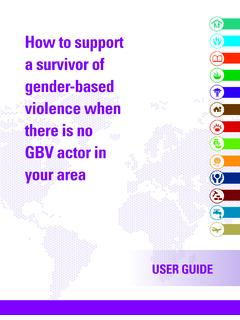


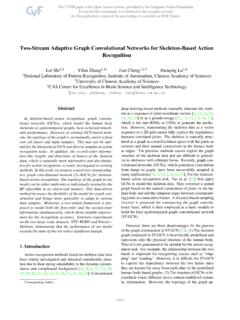
![arXiv:1801.07455v2 [cs.CV] 25 Jan 2018](/cache/preview/c/1/f/1/b/a/a/5/thumb-c1f1baa5f6e090b207f4f18380d23ecd.jpg)

